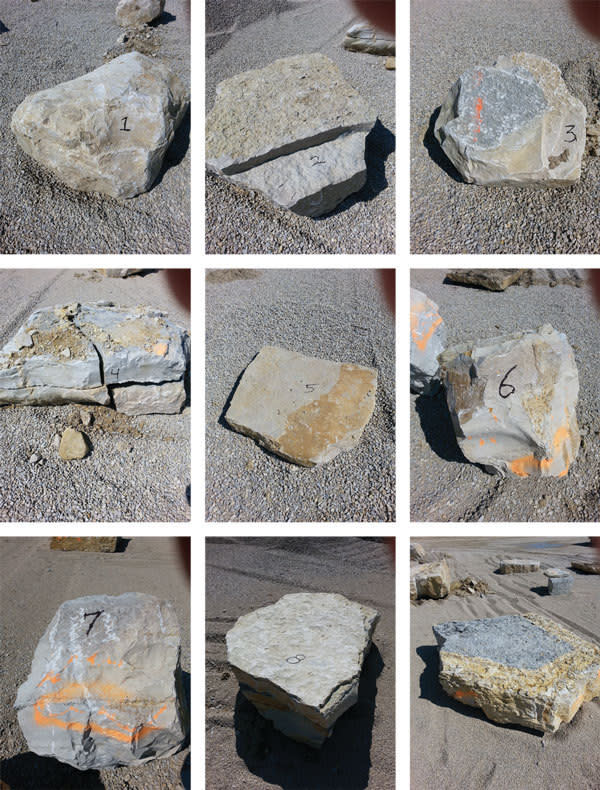Review: Lucy Skaer at Yale Union (YU)

Image: YU Contemporary
For her multi-piece installation, titled MONDAY 8.4.13, TUESDAY 9.4.13, WEDNESDAY 10.4.13, THURSDAY 11.4.13, FRIDAY 12.4.13, SATURDAY 13.4.13, SUNDAY 14.4.13, MONDAY 15.4.13, TUESDAY 16.4.13, WEDNESDAY 17.4.13, THURSDAY 18.4.13, FRIDAY 19.4.13, SATURDAY 20.4.13, SUNDAY 21.4.13, MONDAY 22.4.13 (yes, really), Skaer cleared YU’s grand, arch-window-lined, second-floor space of every distraction, including the lights (the show can only be viewed in the day), to make a stage for her sculpture that is near-ecclesiastical. She hauled some 25 tons of limestone from Iowa and shipped a conference-room-sized chunk of century-plus old mahogany from Belize. She molded gem-shaped, book-sized chunks of unfired terra cotta that she’s carefully arranged in a dramatic grid at one end of the space, a la Carl Andre. She collected printing plates from several days of the UK newspaper the Guardian (from which the show’s title comes), and made prints using YU’s impressive presses and studio. She meticulously punched the centers out of a 35mm film she made in Leeds and mixed the rectangular pieces into a gum resin, usually used for chewing gum and baseball bat grips, and then filled one whole corner of the gallery with the concoction. The leftover film—all frame, no center—plays downstairs in one of the windowless spaces in the YU rabbit warren.
Sklar hails from a tradition of academically brainy UK sculptors. Hop the streetcar to PSU’s Urban Center and you can find the permanent installation of another, John Aiken: huge, eccentrically shaped granite pieces dotting the plaza (though, if you want to truly “get it,” don’t miss the pieces inset into the floor of the building just to the north). Every one of Skaer’s pieces has a story, which she thoughtfully shared during a recent walk-through: the large limestone pieces come from a quarry that once was the US’s major source of stone printing plates. The mahogany, once used to make Victorian furniture and harvested to extinction for pieces so large, was sunk for all these decades in a river. A beautifully crafted, limestone topped, elliptically shaped table is an exact copy of a table she had in her recent apartment in New York. The Guardian’s plates—erased but for a few abstract remnants—portray news about Tiger Woods, the Boston bombing, and Maggie Thatcher’s death, all of which happened during Sklar’s visit to the Iowa quarry and her move back to the UK from New York. The ink is terra cotta colored to tie in with the gem-shaped clay pieces on the floor.
Lucy Skaer
YU Contemporary
Thru Sept 12Everything about this show tugs hard on my hopes. The big idea is a juxtaposition of orders of time and memory: geologic, historic, and personal. When I was still making art, years ago, those were my themes. The show’s curator, Hope Svenson, thoughtfully invokes a beautiful passage from John McPhee’s seminal meditation on humans and geology, Basin and Range, one of my favorite books, partly because it explores the landscape of where I grew up. I’m an ex-newspaper writer and have always been drawn to artists who use mass media as medium: Gerhard Richter, Hans Haacke, Richard Prince, to name only a few. YU’s space has yet to be used so thoughtfully, down to the necessary placement of the limestone chunks over this barely engineered (woe to anyone inside during the Big One) architecture’s structural columns.
In short, I should love this show.
But I don’t.
To Skaer’s credit, she is exploring fascinating lines between meaning and not meaning, the personal, the historic, and the universal. Based on past work I’ve seen in reproduction, it appears she is often successful. But viewing this show mostly sharpens my longing for the sensual pleasure (or challenge) of the purely visual, to connect with something upon the first encounter without the need for explanation.
Maybe that’s her goal, too, and this time she came up short. Or maybe I’m the one coming up short. Thanks to YU for giving her the space and resources to allow her to pose that question to anyone who visits the show. Go see this ambitious work yourself, and see if it finds success for you.
